In the Footsteps of Captain Cook
Part 1 – Raiatea & Tahaa
We were fortunate enough to have good friends, Bob and Diane, who invited us and another couple to join them on a dream holiday to Tahiti. Our travels began with a Thursday flight from Orlando to Los Angeles, where we boarded an 8-hour, overnight flight on Tahiti Air to Papeete, the capitol of Tahiti.

Tahiti is one of “The Society Islands”, part of French Polynesia that is still maintained as part of France. After being greeted in Papeete with beautiful fresh leis, we caught a short turbojet flight on local Tahiti Nui Airlines to the nearby island of Raiatea. From there, it was a short transport ride to Marina Apooiti, where we boarded our Lagoon 40 Catamaran from Tahiti Yacht Charters. After “check-out”, loading supplies, and unpacking, we set out into the lagoon at ~1:00pm for our first sail. The boat is fairly modern, with 4 double cabins, (2 in each pontoon), including another small “bow cabin” in each, and 4 bathrooms with electric toilets. Each cabin is equipped with an air conditioner, and the boat also has a generator, microwave, dingy with motor, stand-up paddleboard, and kayak.
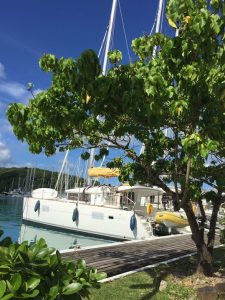
The Society Islands are part of a volcanic arc, created as the earth’s crust moves over a “hot spot” that periodically results in a sea mount that emerges from the deep ocean. These islands are all ringed by coral reefs that mostly surrounds them and limits the approached to the islands. The island of Raiatea, and the very nearby island of Tahaa, are surrounded by a single coral reef that rings them nearly 1-mile offshore, leaving a 300’ deep navigable lagoon between the island and the reef. Occasionally, small pieces of land appear as islands out on the exposed coral reef, commonly referred to as “motu’s”. Since we only have the boat chartered for a week, we decide to spend our time circumnavigating these 2 island within their lagoon. For our first night, we sail and motor a short way to the southern end of Tahaa, where we pick up a mooring ball in Apu Bay to partake in the weekly Friday night beach feast and show at “La Ficus”, hosted by a local named Jerimiah, his family and friends. The food is typical Polynesian fare, prepared on hot rocks and wrapped in banana leaves. It included fish, chicken, beef, beans, potatoes, plantains, eggplant, “barrel root” (cassava), and a variety of fruits. All served with local juice, beer and wine, and accompanied by Polynesian dancing, singing and fire play, for a wonderful evening.
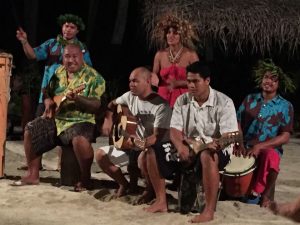
Saturday morning, we took a leisurely breakfast on-board, and then went to investigate a local, family-run pearl farm on Apu Point called Champon Pearls. The Society Islands provide most of the world’s cultured black pearls. Champon nurtures about 30,000 black-lip oysters. The oysters are purchased as “spat” and raised for 18 months in hanging baskets to maturity. Every few months, they are brought up and cleaned from algae and other organisms. At ~18 months, the oysters are brought up and opened slightly, where a “foreign” piece of flesh, (grafts), from another oyster is implanted along with a small, spherical piece of shell from Louisiana oysters. The oyster’s immune system build a sack around the foreign material and coats the Louisiana nucleus with its own mother-of-pearl. Each oyster has a unique mother-of-pearl color ranging from pink to green to blue to bronze to black. The oysters are returned to the lagoon waters where it takes another 18 months for the pearl to develop. They are again taken up, opened slightly, and the pearl is extracted. In its place, another Louisiana nucleus of the now larger size is emplaced. Then the process is repeated to create a larger size pearl. An oyster can produce for about 3-to-5 cycles, with each cycle creating a larger pearl-coating over an ever-larger nucleus. Only about 30% on the pearls of are gem quality, with spherical shape, uniform color and no flaws. The others are also used in jewelry, but are of lesser value.
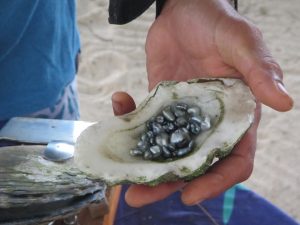
After shopping at Champon Pearl Farm, we returned to the boat, and continued our journey south to the east coast on Raiatea. The wind was perfect, and we got the boat up to ~7 knots while sailing. Halfway down the island, we entered Faaroa Bay where we again picked up a mooring ball, and then decided to explore up the Faaroa River by dingy. After braving a brief rainstorm, we were met on the river by a local fisherman in a kayak, James, who offered to take us to his home and show us his crops and plantation. We followed James in his kayak with our dingy up river to a landing where we walked through beautifully tended grounds of gardens, small crops and trees. James gathered local bananas, grapefruit and coconuts for us, while telling us of his family’s house and lands, showing off the scenery, introducing us to his dogs, and described the details of the local flora. He then ducked into his family’s vanilla bean greenhouse and shared a few mature vanilla beans with us, which we would make use of that night on board our boat. We finally thanked him and took our leave back to the boat where we prepared a dinner of mahi-mahi with a salad and homemade sauce of milk, vanilla, coconut and olive oil that was delicious!
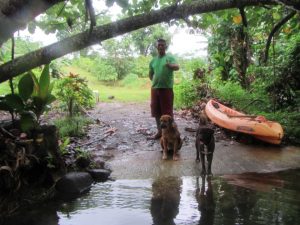
Sunday morning, we continued south to Opoa Bay to look for a mooring ball from which we could go to shore to investigate the archeological Marae Taputapuatea. A Polynesian Marae is a stone structure that was used as a site of gathering to worship and meet with the many tribes. Marae Taputapuatea is one of the most important preserved sites as it is believed to be the site from which Polynesian ocean excursions left to populate the Hawaiian Islands, New Zealand and most of Polynesia. Unfortunately, there were no mooring balls or anchorages there, so we continued south to the next bay, Hotopuu Bay. Here we found a mooring ball, and, after taking the dingy to shore, we made our way along the local coastal road by walking ~30 minutes to Marae Taputapuatea.

At the Marae, we explored the ruins, the flora, and read the placards that were conveniently in Polynesian, French and English. It is reported that when Captain James Cook discovered these islands in 1779, that he witnessed a human sacrifice here! After fully exploring the site, we interrupted our walk back for a stop for nibbles and drinks at the Hotel Atiapiti, a quaint establishment on the point with a modest number of cabins. The owner was extremely gracious and after sampling the local beer, Hinano, and a local vodka-infused beer, Tabu, we bought a few bottles of liquor and made our way back to the boat, and set a course continuing south to Nao coral reef for snorkeling. After setting anchor, we took the dingy to the motu island of Haio where we snorkeled for an hour among the coral heads, colorful reef fish and blue-lipped clams.
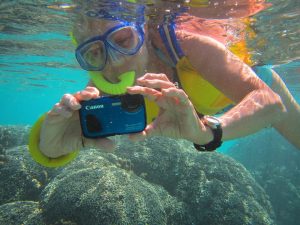
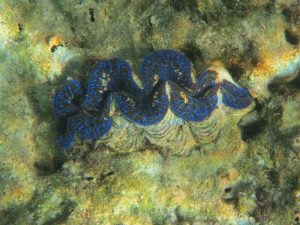
After returning to the boat, we motored a short way to Tuatua Bay to get a mooring ball for the night, and watch the local village having a barbeque picnic onshore and preparing for an outrigger canoe race in the coming week. We passed the evening with nightcaps and a rousing game of cards – “Uno”!
Monday is “May Day” and a National Holiday in French Polynesia. In the morning, our generator stopped working, so we headed north to the port of Utoroa, where the Charter Company sent a repairman to discover is was a blown fuse. While repairs were being made, the girls went shopping for supplies at the local market, and the boys refueled the boat. When all was complete, we continued our journey north to the island of Tahaa and into Haamene Bay for the night. This evening, we went ashore to the classic restaurant “Hibiscus” for dinner, operated by an old Frenchman and his family. After a great fish dinner and bantering with the locals, we finished off the evening back at the boat with a fine port and another round of cards.
Tuesday is May 2nd, and today we traveled a short distance to the “Mahaea” reef, dropped anchor and took the dingy ashore on a “private” motu generally used by “Windstar Sailing Cruises” for guests when then are in the area. Since it was deserted now, we went ashore and used it as a base for snorkeling all around the island seeing many coral heads, fish, nautilus shells and sea creatures of all kinds. Stranded on the motu is also a stray cat, whom we fed and gave water to, and after Bob practiced his native coconut opening skills, we headed back to the boat for lunch, and then continued sailing to the town of Patio located on the north end of Tahaa. Patio is a very small town, but with a grocery where we could resupply our provisions. That night, we stayed at a mooring ball within the lagoon, but just off the village’s coast and enjoyed a dinner of grilled lamb chops with scalloped potatoes. However, at 2:00am, we were suddenly awakened as the catamaran violently pitched exactly once. We immediately went on deck to see what caused the huge disturbance only to find no vessels, no wakes and nothing but complete, moonlit calm. We found this situation very strange, and, after talking with locals, considered the possibility that we were “bumped” by a whale who occasionally traverse the lagoon’s waterways! Who knows?
Wednesday, May 3rd was Debbie’s birthday, and we started the morning with balloons, party hats and a birthday breakfast. After festivities, we set off to continue our counterclockwise circumnavigation of Tahaa. After a short trip, we stopped at the Love Pearl Farm where we had the opportunity to watch a Chinese professional inserting grafts into oysters. From there, we went a short ways to another commercial establishment, Orina Pearl Farm, where they were actively harvesting pearls from a set of their 300,000 oysters. After shopping there, we sailed to Tapuimae Bay, where we picked up a mooring ball opposite the island’s cargo dock. From here, we took the dingy all the way across the lagoon to a deserted motu next to Tautau motu where a large, private resort was located with overwater cabins. Between the motu’s is an area of tremendous coral growth known as “the Coral Gardens”. We landed the dingy on the south end of the motu, and then walked with our snorkel gear to the north end of the motu, where we entered the “Coral Garden” and used the local current to take us back towards our dingy. “The Coral Garden” was certainly one of the most amazing snorkeling experiences we had ever experienced, with narrow canyons winding through colorful coral that reaches to the surface, and abundant reef fish everywhere. We even encountered a massive Moray Eel that measured over 8 inches in diameter and nearly 5 feet long! The snorkel trek back took us over an hour after which we collected up our belongings and began the long dingy ride in the rain, back to our boat across the lagoon. That night, we had a birthday celebration on board with chicken, veggies, a banana desert and chocolate.
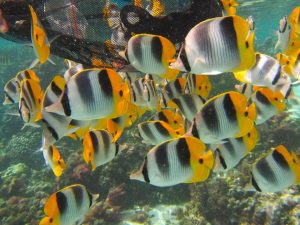
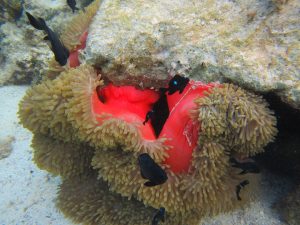


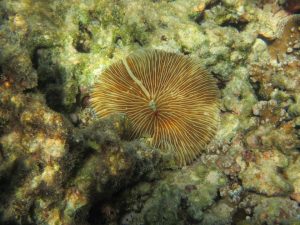
Thursday, we were up early for a short resupply trip to the dock for eggs, wine and ice, and to dispose of our recyclables and trash. There, we met a local young woman, Jessica” who ran a little shop and told us where to find the Peri-Peri Rhum Distillery and Vanilla Farm on the opposite shore. We took the dingy there, and after traversing the shallows, made our way to the establishment where we were greeted by the French Manager, who took us on a tour and tasting of their use of coconuts for oils and soaps, their raising of vanilla used in their rum, creams and vinegar, and the processing of their sugar cane into 70, 75 and 80 proof rum.
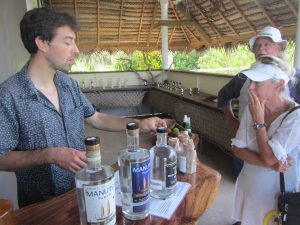
After buying samples, we set sail for Hurepiti Bay where we had lunch on board, and then explored the shore via kayak looking for the local horticultural tours. After locating “Vanilla Tours” proprietor, Noah (+689-40-65-6246), we were disappointed to learn that his tours include the whole island and take over ½ a day. However, Diane negotiated a more compressed version that would include a stroll around his property and the local area with description of the local flora. Noah was born in Tahaa of French parents who visited there and stayed years before. After studying in University in Paris, he returned to take over the family’s business and introduced us to the wide variety of garden plants, fruits and trees that populate the island. At the end of the tour, he sent us on our way with a collection of coconut, grapefruit, guava and papaya. From there, we completed our circumnavigation of Tahaa by again taking a mooring ball in Apu Bay, and arranging a “private” dinner for the night at “La Ficus”. Jerimiah was the consummate host, opening the establishment just for us 6, and providing not only a fantastic meal of beef, pork, ceviche and a revered crustacean, “skee” (a sort of Polynesian lobster that actually is a large Mantis Shrimp), but also talked, played instruments and sang with his family for us for most the night. A truly magical evening! That night, the generator failed again for unknown reasons, but our final night on board was cool and comfortable.
The next morning, the generator started back up fine and we took the boat back to the marina in Raiatea to turn it in, ending the first leg of our Polynesian adventure. After successfully checking the boat in, getting cleaned up and eating lunch at the marina, we took a transport back to the airport for our short flight from Raiatea to the nearby island of Bora Bora!

